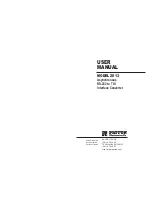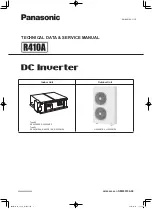
Page 36
©
2020 Sensata Technologies
Operation
3.2.3 Load
Support
While in the Standby Mode and the charger is enabled, the MSH3012RV inverter/charger has the
ability to work in parallel with the incoming AC source (utility or generator power) to power the
AC loads using current from the batteries. During the Standby mode, the current and voltage
from the AC source and the current used by the AC load are continually monitored. When loads
on the inverter output exceed the maximum available current from incoming AC source, the Load
Support feature is automatically activated. The Load Support feature causes the MSH3012RV
inverter/charger to reduce/stop the battery charging operation and begin using current from the
batteries along with the maximum available current from the AC source to ensure the AC loads
are powered. The Load Support feature turns off once the load demand decreases and there is
suf
fi
cient current from the incoming AC source; when this happens, the battery charger is again
activated and begins charging the batteries.
For the Load Support feature to automatically function, the following needs to occur:
1. An AC source (utility power/AC generator) must be connected.
2. The inverter must be enabled (INV LED is on).
3. The battery voltage must be
≥
0.5 volts above the LBCO setting (10 VDC default).
Info:
If using a remote that is able to show the load support status and the unit is in
load support, the status will indicate either “Load Support AAC” or “Load Support VDC”.
Info:
The load support feature of the MSH3012RV can provide 60 amps on its AC output.
For example, if the input AC source is 40 amps, load support can add up to 20 amps; if
the input is 50 amps, load support can add up to 10 amps of additional current.
Info:
The load support feature is monitored thru the AC HOT 1 IN terminal. When the
AC HOT 1 IN is the only input connected to the incoming AC source, then load support is
provided to the loads connected to both the AC HOT 1 OUT and AC HOT 2 OUT terminals
However, if the AC source is connected to both the AC HOT 1 IN and the AC HOT 2
IN terminals [from either a split-phase (120/240VAC) or three-phase (120/208VAC)
source], the Load Support feature is only provided and supports the loads connected
to the HOT 1 OUT output. In this instance, the AC HOT 2 OUT output is only pass-thru
power coming from the AC HOT 2 IN terminal
Info:
The input amps (or shore amps) setting on the remote control should be set
≥
5
AAC for the load support feature to limit and support the incoming amperage correctly.
There are two modes of operation within Load Support.
• Load Support AAC
– In this mode, the AC loads connected to the inverter output are requiring
more power than the incoming AC source can provide on its own. The inverter pulls the additional
current—that is needed for the loads—from the inverter batteries to keep the incoming AC
current from exceeding the input amps setting on the remote control.
Info:
In Load Support AAC, even though the LED indicators may indicate charging,
the inverter/charger may not be putting current into the battery. If using a remote,
the Inverter/Charger Amps AC meter indicates the load support process by displaying
negative current
fl
owing from the batteries to the loads. The input amps AC value will
also drop during this process, while the load amps AC value remains the same.
• Load Support VDC
– In this mode, an external DC source (i.e., alternator, solar, etc.,) is
causing the battery bank voltage to rise above the temperature-compensated battery voltage
setting on the remote control. If this happens, the inverter/charger will reduce the incoming
AC current and use current from the batteries to support the inverter load.
Info:
The charger must be enabled (not in ‘Charger Standby’) and in the Absorb or Float
charge mode (with at least a 6-amp inverter load) for the Load Support VDC feature to
be active.
Note: Load Support VDC is not active in either the Bulk or EQ charge modes.
















































